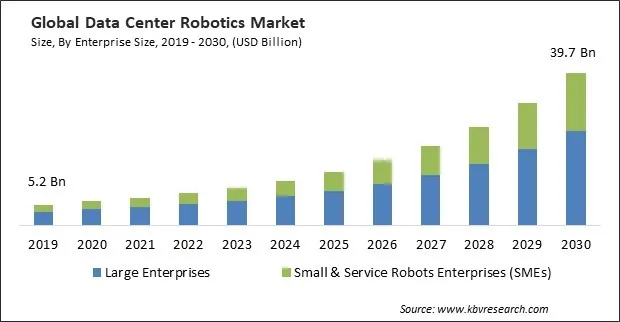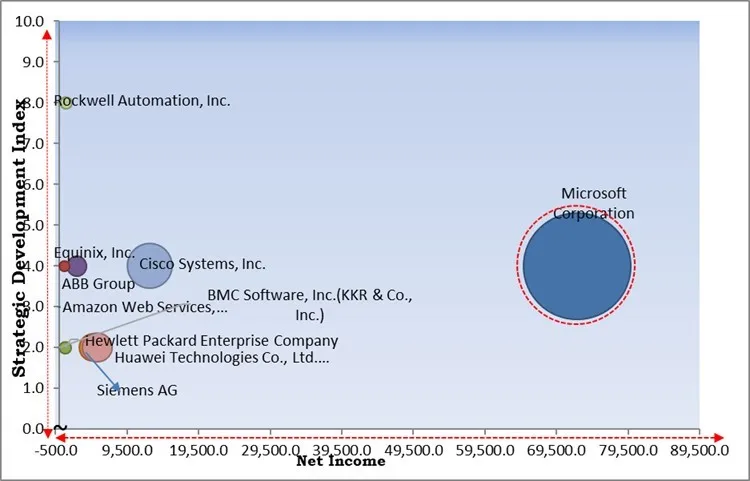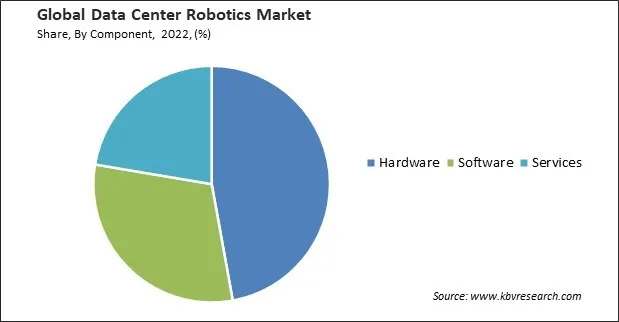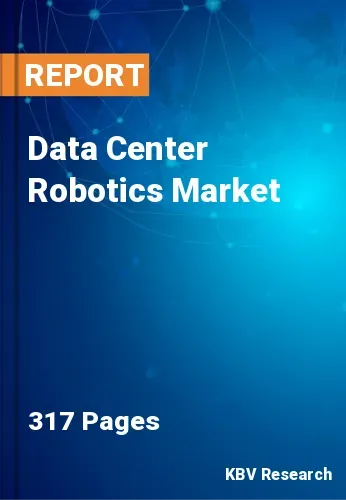The Global Data Center Robotics Market size is expected to reach $39.7 billion by 2030, rising at a market growth of 22.3% CAGR during the forecast period.
Government data centers store sensitive information, and security is paramount. Robotics can enhance security by patrolling the premises, monitoring for unauthorized access, and responding to security breaches. Consequently, the government segment would generate approximately 10.57% share of the market by 2030. This helps in safeguarding classified data and maintaining data center security protocols. Using this technology in the government sector can enhance security, efficiency, and resilience while reducing operational costs. It's essential for government agencies to carefully plan and implement robotics solutions, considering the public sector's specific needs and regulatory requirements.

The major strategies followed by the market participants are Partnerships, Collaborations & Agreements as the key developmental strategy to keep pace with the changing demands of end users. For instance, In May, 2023, Rockwell Automation, Inc. came into partnership with Autonox Robotics. Through this partnership, Rockwell would aim to empower businesses in North America, Europe, the Middle East, and Africa to unlock fresh manufacturing opportunities with comprehensive robot control solutions. In April, 2023, Siemens AG came to partnership with IBM, to create an integrated software solution that combines their capabilities in systems engineering, service lifecycle management, and asset management.
Based on the Analysis presented in the KBV Cardinal matrix; Microsoft Corporation is the forerunner in the Data Center Robotics Market. Companies such as Cisco Systems, Inc., Huawei Technologies Co., Ltd. (Huawei Investment & Holding Co., Ltd.), Siemens AG are some of the key innovators in Data Center Robotics Market. In October 2022, Huawei Digital Power Thailand collaborated with Planet Communications Asia Plc, to enter the Thai data center sector by introducing the Prefabricated AIO Data Center FusionModule DC 1000A. The partnership aimed to raise awareness about prefabricated data center modules in Thailand's markets and was committed to aligning with the country's demand for reliable data centers and the growing zero-carbon trends.

Robotics process automation (RPA) and automation technologies have significantly enhanced the efficiency, scalability, and sustainability of data center operations. RPA in data centers automates routine and repetitive tasks, such as server provisioning, resource allocation, and software updates. This automation reduces manual intervention, saving costs and improving operational efficiency. RPA enables data centers to allocate resources dynamically based on workload demands. This leads to more efficient resource utilization, reducing over-provisioning and under-utilizing hardware resources. This trend has boosted the growth of the market.
The need for data centers is driven by factors such as exponential data growth, cloud computing, remote work, IoT, e-commerce, data security, edge computing, 5G, AI, video streaming, business continuity, environmental concerns, and the expansion of online services. Cloud computing has revolutionized the way individuals and businesses access and store data. Cloud services have become integral to modern computing, and data centers are fundamental to these services. As more organizations migrate to the cloud, data center expansion is inevitable to support cloud computing requirements. The aforementioned factors will expand market growth.
However, deploying and maintaining data center robotics often requires specialized technical skills. Many organizations may lack in-house expertise to manage and troubleshoot robotics systems, leading to challenges in implementing and maintaining such systems. Training personnel to operate and manage data center robotics can be time-consuming and costly. Organizations may hesitate to invest in training programs due to budget constraints or lack of awareness of the benefits. Integrating data center robotics with existing systems and processes can be complex. Organizations may be reluctant to adopt robotics solutions without the technical proficiency to handle these integrations. The rising security privacy concerns will hinder market growth.
On the basis of enterprise size, the market is divided into large enterprises and small & medium enterprises (SMEs). The small & medium enterprises (SMEs) segment recorded a remarkable revenue share in the market in 2022. The fast growth of the SME segment in this market is driven by the convergence of affordability, operational efficiency, scalability, remote management capabilities, competitive advantages, and the alignment of robotics with the specific needs of smaller businesses. As robotics evolve and adapt, SMEs are well-positioned to leverage these technologies to enhance their data center operations and navigate the dynamic business landscape.
On the basis of components, the market is segmented into hardware, software, and services. In 2022, the hardware segment dominated the market with the maximum revenue share. Robotic arms are data center robotics’ most visible and essential hardware components. They are responsible for performing physical tasks such as server installation, maintenance, and component replacement. These arms often have various end-effectors (tools or grippers) to perform specific tasks. Moreover, high-performance computing hardware is essential for processing data, making real-time decisions, and controlling the robotic system. This includes CPUs, GPUs, FPGAs, and embedded systems. Hardware components for safety include emergency stop buttons, collision detection systems, and safety barriers to protect robots and human operators.

By robot type, the market is categorized into collaborative robots, industrial robots, and service robots. The collaborative robots segment covered a considerable revenue share in the market in 2022. The collective robotic growth is attributed to its diverse IT expertise. The growing diversity has prompted knowledge sharing and fostered collaboration and innovation in a business setup. The collaborative robotic data center prioritizes investing in sustainability and energy-efficient technologies. Moreover, collaborative robotic data centers facilitate manufacturing and production-related tasks such as material handling, machine tending, and product quality control.
Based on vertical, the market is classified into BFSI, healthcare, education, IT & telecom, government, retail & e-commerce, and others. In 2022, the IT & telecom segment generated the highest revenue share in the market. This is due to the wide acceptance of enhanced technologies like IoT, cloud computing, and AI, which generate vast amounts of data. The impact of emerging trends like AI, IoT, and cloud computing on the data center industry is unquestionable, including increased performance demands, potential security risks, and the need for more efficient and flexible data center infrastructure.
| Report Attribute | Details |
|---|---|
| Market size value in 2022 | USD 8.3 Billion |
| Market size forecast in 2030 | USD 39.7 Billion |
| Base Year | 2022 |
| Historical Period | 2019 to 2021 |
| Forecast Period | 2023 to 2030 |
| Revenue Growth Rate | CAGR of 22.3% from 2023 to 2030 |
| Number of Pages | 473 |
| Number of Table | 317 |
| Report coverage | Market Trends, Revenue Estimation and Forecast, Segmentation Analysis, Regional and Country Breakdown, Competitive Landscape, Companies Strategic Developments, Company Profiling |
| Segments covered | Component, Robot Type, Enterprise Size, Vertical, Region |
| Country scope | US, Canada, Mexico, Germany, UK, France, Russia, Spain, Italy, China, Japan, India, South Korea, Singapore, Malaysia, Brazil, Argentina, UAE, Saudi Arabia, South Africa, Nigeria |
| Growth Drivers |
|
| Restraints |
|
Region-wise, the market is analyzed across North America, Europe, Asia Pacific, and LAMEA. The Asia Pacific region garnered a significant revenue share in the market in 2022. The Asia Pacific region is undergoing a rapid digital transition, with rising usage of big data, cloud, artificial intelligence, and the Internet of Things (IoT). Data centers must become more scalable, efficient, and capable of managing complex workloads as data volumes increase. Robotics can assist in meeting these demands. Many APAC countries face skilled labor shortages, specifically in technical and engineering positions. Robotic solutions could relieve these shortages by automating routine operations and freeing trained workers for higher-value work. The competitive nature of the APAC technology sector leads companies to seek creative methods to distinguish themselves. Robotic data centers can be a unique selling factor and assist in developing a company's reputation.
Free Valuable Insights: Global Data Center Robotics Market size to reach USD 39.7 Billion by 2030
The market research report covers the analysis of key stakeholders of the market. Key companies profiled in the report include ABB Group, Amazon Web Services, Inc (Amazon.com, Inc.), Microsoft Corporation, Equinix, Inc., Cisco Systems, Inc., Siemens AG, BMC Software, Inc. (KKR & Co., Inc.), Huawei Technologies Co., Ltd. (Huawei Investment & Holding Co., Ltd.), Hewlett Packard enterprise Company, and Rockwell Automation, Inc.
By Enterprise Size
By Component
By Robot Type
By Vertical
By Geography


This Market size is expected to reach $39.7 billion by 2030.
Advancements of smart data centers through integration of RPA are driving the Market in coming years, however, Lack of technical proficiency and awareness restraints the growth of the Market.
ABB Group, Amazon Web Services, Inc (Amazon.com, Inc.), Microsoft Corporation, Equinix, Inc., Cisco Systems, Inc., Siemens AG, BMC Software, Inc. (KKR & Co., Inc.), Huawei Technologies Co., Ltd. (Huawei Investment & Holding Co., Ltd.), Hewlett Packard enterprise Company, and Rockwell Automation, Inc.
The expected CAGR of this Market is 22.3% from 2023 to 2030.
Large Enterprises is leading the Market by Enterprise Size in 2022, thereby achieving a market value of $24.5 billion by 2030.
The North America region dominated the Market by Region in 2022, and would continue to be a dominant market till 2030; thereby, achieving a market value of $13.9 billion by 2030.
Our team of dedicated experts can provide you with attractive expansion opportunities for your business.

